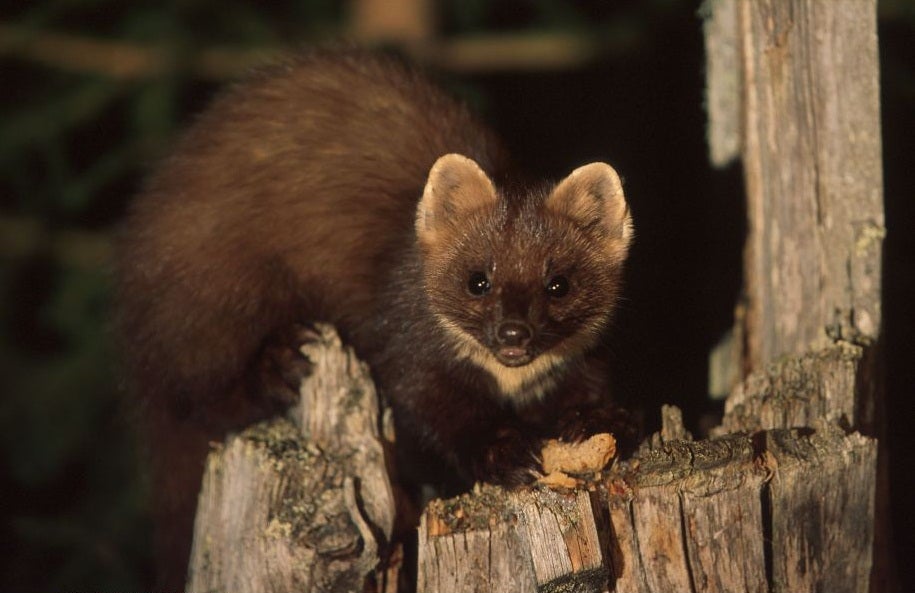Nature Studies: Could we one day see pine martens in the woods of southern England?
With its sinuous, long-tailed elegance, Martes martes is ravishingly attractive

The radical idea that we should bring back to Britain the large carnivores we long ago wiped out – lynx, wolf, even brown bear – is increasingly being discussed as part of the topic of “rewilding” the impoverished natural world of our country; and it is provoking a fair amount of heated debate. Just a fortnight ago, Paul Lister, the multimillionaire heir to the MFI furniture fortune, told The Independent that he wanted to bring back all three – yep, bears included – to his large private estate in the wilds of northern Scotland.
How realistic such a scheme may be is a moot point. But, with hardly anyone noticing, a project has just got under way which is entirely realistic, and may well see another missing carnivore brought back; not to the Highlands, where the lynx et al might one day roam, but to Wales and England, and even to the gentler landscapes of the south, such as the New Forest.
The carnivore in question is the pine marten, the larger, tree-dwelling relative of the stoat and the weasel (a mustelid, to be technical). With its sinuous, long-tailed elegance and its cream-coloured throat contrasting with the rest of its chocolate-brown body fur, it is a ravishingly attractive mammal, and pine marten tourism, watching the beastie from a hide, is a growing attraction in parts of Scotland, such as Speyside, where it is flourishing.
Once, pine martens were found all over Britain, but in the 18th and 19th centuries they were largely wiped out because of the rise of the great shooting estates: gamekeepers killed them anywhere and everywhere that they found them, and by the start of the 20th century they were extinct in most of England and Wales and even in much of Scotland. By World War II, they existed only as a relict population north and west of Loch Ness.
Since then, however, Martes martes has spread back across the Highlands and is even found in Scotland’s south, in the forests of Galloway, where it was reintroduced in 1981. And a growing number of conservationists are asking: why not bring it all the way south, back to Wales and even to southern England, where once it may have lived in every patch of wood?
They are led by the Vincent Wildlife Trust, the estimable, small charity which concerns itself with the fate of Britain’s rare mammals. For more than a decade, the VWT has led the way in trying to pin down scanty reports of pine martens still existing elusively in the remoter parts of Wales and Northern England; and what they have proved is that while there are indeed animals remaining in the Principality, and in parts of the north of England, the numbers are so tiny that they are “functionally extinct” and unlikely to start recovering again. So, three weeks ago, the Trust announced a formal, two-year study into the possibility of reintroducing pine martens south of the border.
The study will try to identify areas with suitable habitat and suitable food availability where animals might be released from populations in Scotland, and from Ireland, too, where they are also doing well. If the trial succeeds, a reintroduction plan would be put forward. The key point about this study is that it has official backing: on its steering group are representatives of all the main Government conservation bodies and it is enthusiastically supported by Natural England, Natural Resources Wales, and the Forestry Commission, as well as other wildlife charities.
Less keen on the idea are people who like to shoot game birds, some of which the reintroduced animals might consume. “Pine martens are carnivores and do eat things, and some people aren’t very happy about that,” said Lizzie Croose, the Trust’s project officer. “So we will be working closely with the game shooting lobby, and bird conservation groups as well.” Wisely, the Trust has included the British Association for Shooting and Conservation on the study steering group.
My own view is that the loss to pine martens of just a few of the 35 million pheasant poults released in the British countryside to be shot every year, would be a microscopic price to pay for the return of such a charismatic mammal. And while we’re on the subject of the clash between shooting interests and natural predators, I said in this column last week, while writing about the newly published Bird Atlas of Britain and Ireland, that the buzzard and the raven have spread back over Eastern England because “persecution has ended.”
That might imply that persecution of avian predators by gamekeepers has stopped all over Britain. It might have lessened in some parts of England, but on the upland shooting estates of the North and in Scotland it is still rife. Last year, the House of Commons Environment Audit Committee disclosed that between 2002 and 2011 there were 633 confirmed bird of prey poisoning incidents in the UK, with species killed ranging from golden eagles and white-tailed eagles to peregrine falcons; I am only too happy to point that out.
Join our commenting forum
Join thought-provoking conversations, follow other Independent readers and see their replies
Comments